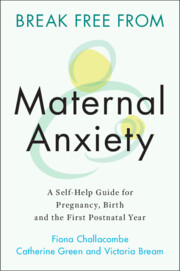 Break Free from Maternal Anxiety
Break Free from Maternal Anxiety Book contents
- Reviews
- Break Free from Maternal Anxiety
- Break Free from Maternal Anxiety
- Copyright page
- Dedication
- Contents
- About the Authors
- How to Use This Book
- Acknowledgements
- 1 Introduction
- 2 Persistent and Distressing Worry
- 3 Unwanted Intrusive Thoughts of Harm (Obsessive Compulsive Disorder)
- 4 Specific Phobias Affecting Pregnancy and the Postnatal Period
- 5 Panic Attacks and Health Worries
- 6 Feeling Anxious Around Other People
- 7 Coping with Traumatic Experiences While Pregnant and After Birth
- 8 Anxiety About Pregnancy and Birth
- 9 Anxiety and Adjusting to Motherhood
- 10 Beyond the Perinatal Period: Taking Your New Skills Forward into Parenthood
- Appendices
- References and Resources
- Selected Resources (A Complete List Can Be Found Online)
- Index
4 - Specific Phobias Affecting Pregnancy and the Postnatal Period
Published online by Cambridge University Press: 13 October 2022
- Reviews
- Break Free from Maternal Anxiety
- Break Free from Maternal Anxiety
- Copyright page
- Dedication
- Contents
- About the Authors
- How to Use This Book
- Acknowledgements
- 1 Introduction
- 2 Persistent and Distressing Worry
- 3 Unwanted Intrusive Thoughts of Harm (Obsessive Compulsive Disorder)
- 4 Specific Phobias Affecting Pregnancy and the Postnatal Period
- 5 Panic Attacks and Health Worries
- 6 Feeling Anxious Around Other People
- 7 Coping with Traumatic Experiences While Pregnant and After Birth
- 8 Anxiety About Pregnancy and Birth
- 9 Anxiety and Adjusting to Motherhood
- 10 Beyond the Perinatal Period: Taking Your New Skills Forward into Parenthood
- Appendices
- References and Resources
- Selected Resources (A Complete List Can Be Found Online)
- Index
Summary
Phobias, strong fears related to particular situations, are the most common anxiety problems. People often find a way to live with them in normal life, often by avoiding situations that trigger the fear. Pregnancy and the postnatal period makes this very difficult in the case of two particular phobias, fear of blood, injections and injury (BII) , and fear of vomiting. These situations are impossible to avoid completely at this time and can therefore be very distressing. Fear of vomiting is often related to early memories of this, and keeps going in the present by avoidance and taking particular precautions that keep the anxiety going. This chapter will help you understand and work through these factors to tackle your fears. BII is unique in triggering a fainting response and probably has a large genetic component rather than being learned. We describe proven techniques to apply during exposure exercises to counteract the fainting response triggered in BII, which are known to have a long-lasting effect. Getting on top of these fears will help you manage and enjoy pregnancy and the postnatal year.
- Type
- Chapter
- Information
- Break Free from Maternal AnxietyA Self-Help Guide for Pregnancy, Birth and the First Postnatal Year, pp. 92 - 115Publisher: Cambridge University PressPrint publication year: 2022


